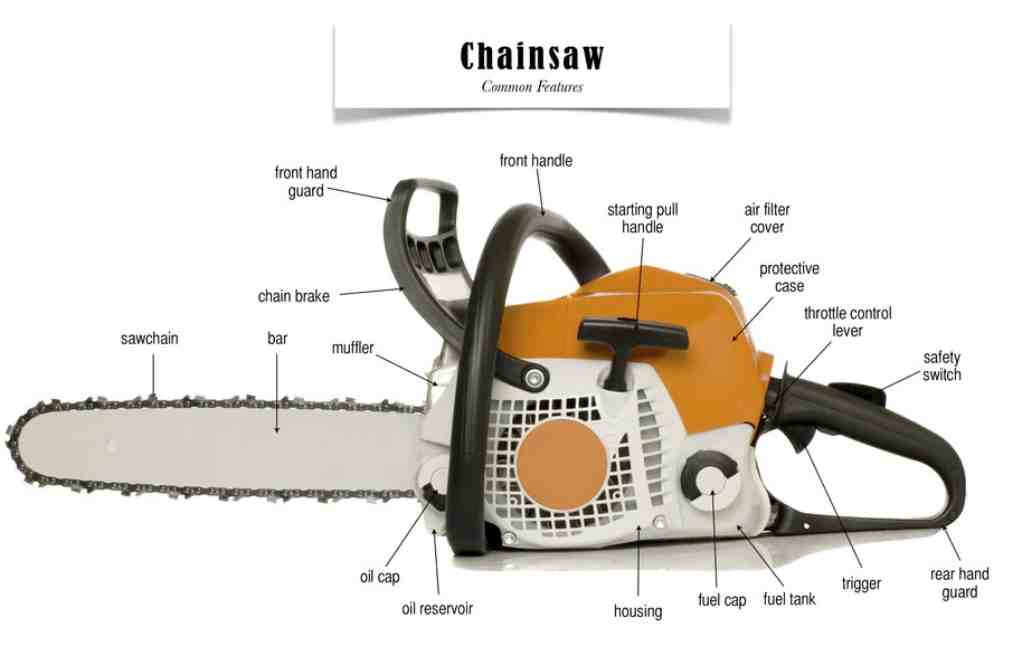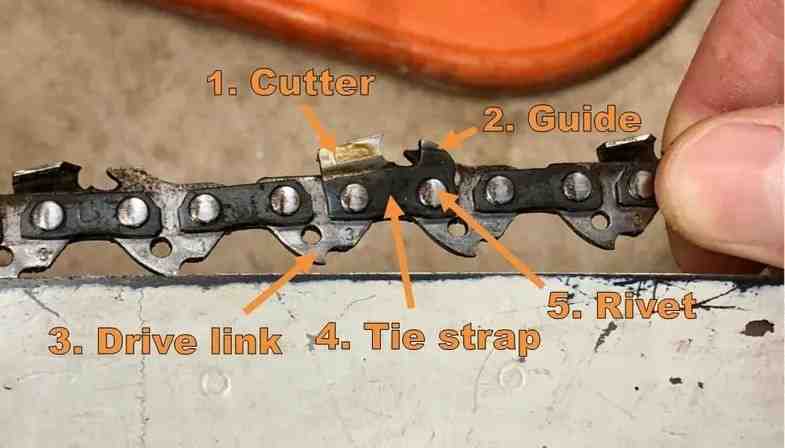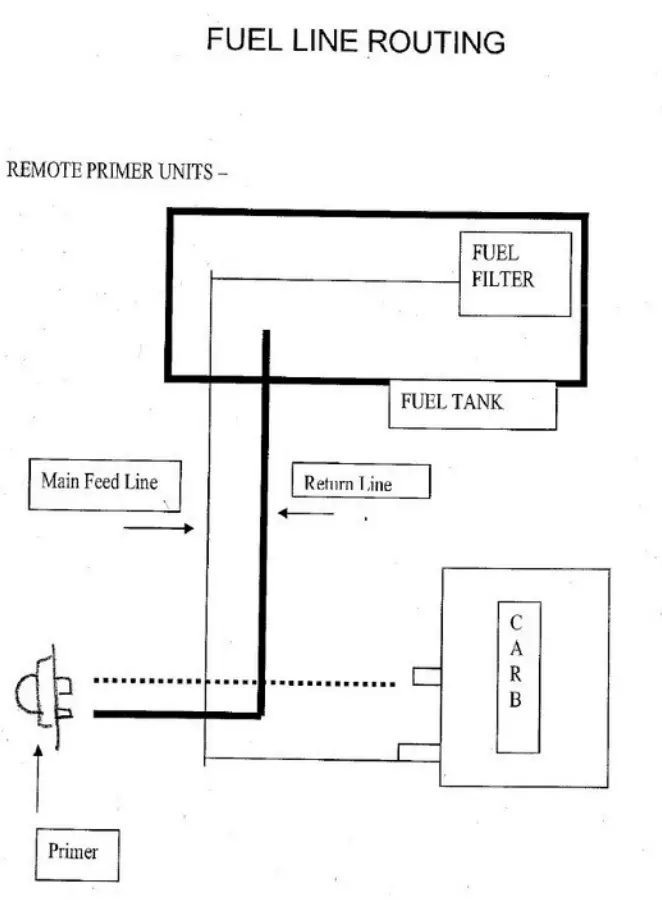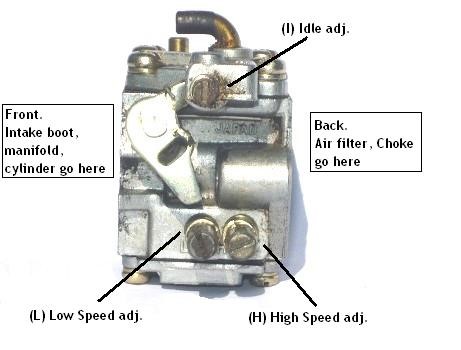Chainsaws may seem complicated but they’re pretty simple in structure for a power tool.
Depending on the model you have, the components of a chainsaw can vary. However, some parts are common in all models.
The external components of a chainsaw diagram include chain, bar, muffler, chain brake, hand guard, pull cord, housing, air filter, trigger, throttle control lever, etc. Internal components include the engine, flywheel, carburetor, etc.
Understanding the chainsaw can help you replace the parts when necessary and operate the machinery more safely than before. So, let’s see what parts are included in making a chainsaw.
Chainsaw Parts Diagram
The chainsaw diagram below represents the external components. There might be some differences in where the parts are positioned, depending on the model you are using.
This can be an excellent guideline for someone who’s getting started with a chainsaw and wants to get familiarized with the structure.

Component Details Of The Chainsaw
To understand the chainsaw better, you need to explore the parts. Let’s take a detailed look at the parts and see why they’re significant.
1. Chain
The chain is a combination of different parts. Here’s a brief demonstration for you.

| Chainsaw Chain Part | Function |
| Cutters | Chips away material to make the cut |
| Guides | Determines the cut’s depth |
| Drive Links | Attaches the chain to the bar |
| Tie Straps | Connects the drive links |
| Rivets | Holds the tie straps in place |
2: Bar
It’s easy to confuse the chain and bar as the blade of the chainsaw. However, they are separate components. Unlike blades, the chain is wrapped around the bar.
The bar, on the other hand, is a piece of metal that also determines the length of your cut along with supporting the chain.
3: Muffler
As the name suggests, this part of the chainsaw is responsible for keeping the noise to a minimum.
4: Chain Brake
One of the most important safety features of a chainsaw is the chain brake. When used, the brake stops the chain from spinning.
5: Hand Guard
The hand guard is responsible for protecting your hands from slipping. The model above has two hand guards, one in front and one in the back.
6: Starting Pull Handle
A handle attached to a rope is responsible for getting your chainsaw started. This part is called the starting pull handle or simply the pull cord.
7: Housing
Housing is in charge of accommodating the engine of your chainsaw and keeping it protected.
8: Air Filter
The air filter of your chainsaw makes sure that the mixture of fuel and air is as proportional as required. It can get dirty over time and require frequent cleaning. You can usually locate the cover from the outside.
9 & 10: Trigger and Throttle Control Lever
The trigger and the throttle control lever both are responsible for running the chainsaw. They ensure that the engine gets the fuel required to run the chainsaw. You must be wondering why both of them are necessary.
Well, this is one of the safety features to ensure that you don’t start the chainsaw accidentally by pressing one of these.
11: Fuel Tank
The fuel tank is for keeping the gas and oil reserved. The fuel travels from the tank to the engine when you run the chainsaw.
12: Lubricant Tank
The lubricant tank stores suitable oil for your bar and chain. It helps reduce friction and heat.
And while we’re on the subject, I should mention that it’s not a good idea to use motor oil for lubricating your chainsaw. It’s toxic and doesn’t have the standard features required by your chainsaw.
If you are searching for suitable lubricants for your chainsaw, here are some recommendations for you:
| Lubricant | Features |
| Renewable Lubricants Chainsaw Oil | Non-toxic.
Biodegradable. |
| DEWALT Biodegradable Chainsaw Oil | Non-toxic.
Eco-friendly. |
| Oregon Bar and Chain Oil for Chainsaws | Premium formulation.
Suitable with all models. |
13: Engine
The engine of a chainsaw is located inside the housing. It’s responsible for running the chainsaw.
14: Flywheel
Another internal component of the chainsaw is a flywheel. It’s responsible for starting the engine and smoothing firing.
15: Carburetor
The chainsaw carburetor diagram is usually simple. Think of the carburetor as a tube attached to the engine. It mixes the fuel with air in accurate proportions to run the engine smoothly.
Understanding the way carburetor works will help you in its adjustments. Besides, it’s also a vital part of the chainsaw fuel line diagram.
You can also check my article on Stihl chainsaw carburetor adjustment if you want.
Chainsaw Fuel Line Diagram
You may have to change your chainsaw’s fuel line, primer bulb, or filter from time to time. This is where the fuel line diagram comes in handy.
Most chainsaws have similar diagram. So, you can use this as a reference when replacing the parts. As you can see, there are three lines in the diagram.
The main fuel line starts from the fuel tank where it’s connected to the fuel filter. It travels to the carburetor and ends there.
Another short line connects the carburetor to the primer. And the last line is for connecting the primer back to the fuel tank.

Chainsaw Carburetor Diagram
The carburetor diagram is important to understand as a part of your chainsaw because you may have to adjust it every now and then.

The screw labelled ‘I’ is the screw for adjusting the throttle valve. Setting it to too low or too high will either be dysfunctional or dangerous.
The screw labelled ‘L’ is responsible for proportionately mix the fuel with air, but at idle speed. Setting it low can make the engine die when runnin at idle speed. On the contrary, setting it too high can make the chainsaw dangerous to use.
The last screw that you use to adjust the carburetor is the one labelled as ‘H’. The function of this screw is similar to the previous one.
The difference between the two is that this one takes care of the gas/air mixture at a cutting speed.
It’s essential to get all the settings right. A perfect combination of the settings is what makes using the chainsaw smooth and safe.
Frequently Asked Questions
What is the function of a summer/winter shutter in a chainsaw?
It allows you to open or close a way to facilitate or obstruct airflow from the outside. In summer, when the air is warm, it’s convenient to let the outside air enter the chainsaw. On the contrary, keeping the airway closed in winter is more convenient because the outside air is comparatively colder.
What determines the chain’s size in a chainsaw?
The size of the chain is extremely important because you can’t use the wrong chain size with a particular bar. There are three components that determine the chain size namely pitch, link count, and gauge.
What is the function of a lubricant tank in a chainsaw?
The lubricant tank accommodates the oil for lubricating the bar and chain. It can decrease the friction and heat caused by running the engine and help the tool run more smoothly.
Wrap Up
When you take the time to go through the chainsaw diagram, using it becomes a lot easier than before. Moreover, you can ensure a safer practice even with a dangerous tool like a chainsaw.
Understanding the components also comes in handy when you’re about to replace the parts. It may save you a fair amount of money of going to a mechanic.
If you can replace the component yourself, the only cost you will have to bear is the cost of the replacement part.
- 2×6 or 2×8 Sill Plate (Which One is Better for Foundation) - September 3, 2023
- Sill Plate vs Bottom Plate (What’s the Difference) - August 31, 2023
- Craftsman Chainsaw Carburetor Diagram (2023) - June 12, 2023
